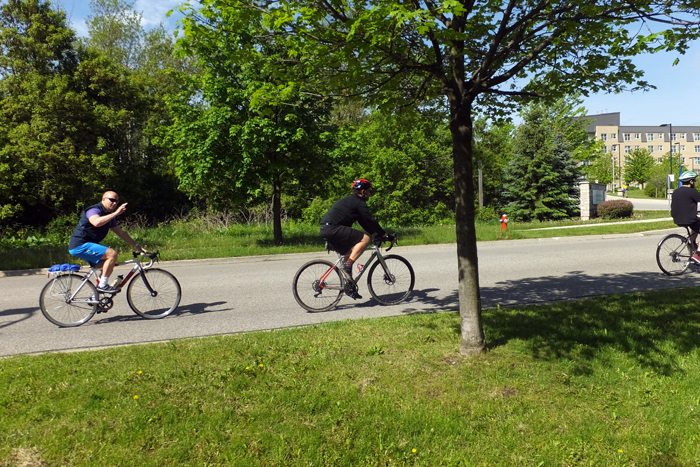Your BikeBrampton friends are working with Mayor Patrick Brown, Regional Councillor Rowena Santos and City Staff on solutions for healthy safe active transportation during this pandemic.
Some of us need to go out to work. Those not in isolation, need to get out for groceries, medicine, and exercise and need guidance on COVID-19.
Region of Peel is experiencing a 33% reduction of vehicular traffic volume according to Manager, Transportation and System Planning.
Google published traffic tracking movement data that shows workplace traffic in Canada is down 44% on average. There is an opportunity to re-purpose this underutilized road space for pedestrians and cyclists. Financial Post
We are noticing anecdotally that more people are using Brampton trails for walking and cycling. As the weather warms, this will put more pressure on the trails, making it more difficult to safely keep 2 metre (6 foot) physical distancing. It is therefore urgent that we come up with a plan.
Research – what are other cities doing in response to COVID-19?
Effective Monday Apr 6th, City of Winnipeg is expanding bicycle and active transportation routes to help with social distancing requirements during the pandemic. Global News Vehicular traffic restrictions will be implemented along four city streets. Winnipeg Public Works announcement
During Mar 28th weekend, the City of Calgary closed traffic lanes. Jose Rodriquez, leader of Public Relations and Media said, “We have proactively closed some traffic lanes so that people can get the physical distance we have repeatedly stressed the importance of”. Mayor Nenshi cautioned residents not to [use] the openings as an opportunity for a street party. Nenshi advised people to stay away from places where people usually congregate and indicated that he would open additional spaces in order to prevent the paths from becoming overcrowded. Six streets in the City were affected by these closures. Global News
Closing Streets to Create Space for Walking and Biking During COVID-19 Webinar Apr 2nd YouTube
Melvin Carter, Mayor of St. Paul Minnesota, Mar 27th announced three roadway closures in response to resident requests for more outdoor room to effectively engage in social distancing. Mayor Carter said, “As an avid runner with a newborn daughter at home, I know that getting outdoors is critical to our well-being — if we can do so responsibly,”. “Our increasingly crowded sidewalks, trails and bikeways demand new spaces and new conversations to ensure we can all safely get out and about.” Twin Cities.com
Jim Filby Willams, Duluth Minnesota’s director of public administration indicated on Apr 2nd, that more road closures were possible. “Duluth sees this as a wellness issue with residents being at home more than usual and needing regular outdoor forays for their mental health”, Williams said. “Our present focus is getting the community through this crisis physically and emotionally. Our goal is not risk elimination but risk management. It would be impractical and foolhardy to try to eliminate all risk by cooping everyone up.” Twin Cities.com
In Philadelphia, road closures are seen as a no-brainer. A portion of the city’s Martin Luther King Drive on Mar 20th was closed indefinitely, 24 hours a day, seven days a week. With recreational-trail traffic quadrupling “and all those folks being concentrated, it was impossible, really, to keep that safe distance,” said Sarah Clark Stuart, executive director of the Bicycle Coalition of Greater Philadelphia. “Everyone was happy and pleased that this could be done so quickly.”
Bogata Columbia Mayor Claudia Lopez said: “The bicycle being an individual means of transport, represents one of the most hygienic alternatives for the prevention of the virus, especially [when] it is recommended to avoid close contact and crowds.” British Columbia Cycling Coalition
British Columbia Cycling Coalition has published a thorough and well researched policy statement on their website regarding COVID-19 and Active Transportation. They cite research related to the health risks associated with confinement during times of anxiety and the ability of physical activity to reduce that risk. It states: “While the patterns of movement and personal interactions must change to slow the spread of the virus and flatten the curve, walking and cycling remain preferred options for any required travel; in particular, active transportation can help us all meet Canada’s physical activity guidelines.” #ridealone British Columbia Cycling Coalition
Richard Florida, Professor at University of Toronto’s School of Management and School of Cities, wrote on Apr 4th: “During this crisis we have all learned that we can be outside for walks or bike rides. Biking and walking will be our safest way to get to and from work. Bike lanes should be expanded, and bike and scooter sharing programs should be, too. Some cities are already pedestrianizing crowded streets to promote social distancing. It makes sense to keep such changes in place for the long haul”. Globe and Mail
What does C.O.V.I.D.1.9 mean?
Shout out to Alina for this clever little acronym (initialism)!

Share your Ideas!
Share your constructive positive suggestions by emailing info@bikebrampton.ca
We will forward suggestions and keep you updated as the Brampton response develops.
Most recent blog post on Cycling in COVID-19 times


You must be logged in to post a comment.